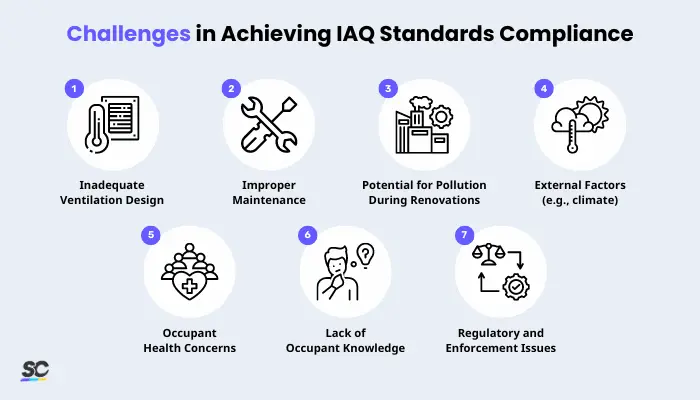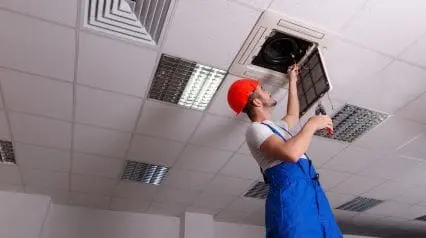What are Indoor Air Quality Standards?
Indoor air quality standards refer to established guidelines and benchmarks that define acceptable levels of air pollutants, contaminants, and conditions within indoor environments such as homes, offices, schools, and public buildings. These standards are developed by governmental agencies, health organizations, and expert committees to safeguard the health, comfort, and well-being of occupants by ensuring that the air they breathe is of a certain quality.
Importance of IAQ Standards for Organizations
The United States Occupational Safety Health Administration (OSHA) states that all employers have the responsibility to provide a safe environment for their employees, including a well-ventilated workplace within the ideal indoor air quality range.
Hence, standards for indoor air quality must be established through extensive research, data collection, and scientific consensus. Complying with such standards is essential to minimize the risk of health problems associated with poor indoor air quality.
Apart from those, here are the other common benefits of compliance with IAQ standards:
- Occupant Productivity and Comfort
- Health and Safety Risk Prevention and Mitigation
- Energy Efficiency
- Improved Resale Value
- Sustainable Living
Different Indoor Air Quality Standards
Regulatory agencies and international organizations develop, update, and enforce IAQ standards to create healthier indoor environments for everyone by providing guidelines for acceptable levels of indoor air pollutants and conditions.
It’s important to note that IAQ standards can vary from country to country due to differences in environmental conditions, building practices, and health concerns. Here are some of the notable ones from various jurisdictions:
Global Standards
- World Health Organization (WHO) – The WHO offers comprehensive guidelines for particulate matter, radon, Volatile Organic Compounds (VOCs), and biological contaminants. These guidelines are internationally recognized and serve as a reference for many countries’ IAQ regulations.
- International Organization for Standardization (ISO) – ISO offers several standards related to indoor air quality, including standards for assessing indoor air quality management systems (ISO 16000-40:2019) and specifying methods to express the quality of indoor air suitable for human occupancy (ISO 16814:2008).
United States
- US Environmental Protection Agency (EPA) – The EPA indoor air quality standards aim to provide guidelines on optimal units of measure for pollutants aimed at providing public welfare protection.
- ASHRAE Standard 62.1 – Developed by the American Society of Heating, Refrigerating, and Air Conditioning Engineers (ASHRAE), this standard focuses on providing guidance on ventilation rates, air distribution, and air cleaning to ensure acceptable IAQ in buildings.
Another important thing to note is that even if there are no exact OSHA indoor air quality standards, the General Duty Clause of the OSH Act still requires employers to provide a safe workplace free of any known hazards that may cause injury or death to workers.
Canada
Health Canada sets specific guidelines for residential IAQ based on the assessment of the risks posed by specific indoor pollutants to help ensure safe and healthy indoor environments.
Australia
While the Australian government recognizes the fact that Australia currently has no specific controls on IAQ compared to the USA, the guidelines on workplace situations state that employers must ensure safe working conditions and ventilation as per Safe Work Australia.
United Kingdom (UK)
The Health and Safety Executive notes Regulation 6 under the Workplace Health, Safety and Welfare Regulations, which states that employers must ensure all enclosed workplaces are well-ventilated by a sufficient quantity of fresh or purified air.
European Union (EU)
The EU has also established IAQ standards to address pollutants such as benzene, carbon monoxide, and other VOCs. Note that under the EU law, there are also permitted exceedances per year for each identified pollutant.
Tips on Adhering to Indoor Air Quality Standards
To help individuals, businesses, and institutions ensure compliance with IAQ standards, they must take the following practical tips:
- Ensure regular ventilation and air exchange.
- Use low-emission products.
- Keep indoor spaces neat by regular cleaning and maintenance.
- Maintain indoor humidity levels within the recommended range (usually between 30% and 50%) to prevent mold and dust mite growth.
- Implement a strict no-smoking policy indoors to prevent exposure to secondhand smoke, a significant indoor air pollutant.
- Schedule regular Heating, Ventilation, and Air Conditioning (HVAC) system inspections and maintenance to ensure they function efficiently and effectively. Also, change HVAC and air purifier filters as manufacturers recommend to maintain clean indoor air.
- Use integrated pest management strategies to minimize the need for chemical pesticides, reducing indoor air pollution.
- Inspect buildings for water damage, leaks, and signs of mold growth regularly, addressing any issues promptly.
- Educate occupants about IAQ standards, the importance of proper ventilation, and best practices for maintaining a healthy indoor environment.
- Consider using IAQ monitoring systems like SafetyCulture (formerly iAuditor)’s Sensors that provide real-time data on indoor air quality, allowing timely intervention when needed.
Explore SafetyCulture Monitoring Solution
Utilize advanced sensor technology to monitor assets, automate vital alerts, implement actions, and report urgent issues.
Talk to an expertChallenges in Achieving IAQ Standards Compliance

Challenges in Achieving IAQ Standards Compliance
Maintaining compliance with IAQ standards can be a complex endeavor, as various challenges can arise due to the following reasons and factors:
- Inadequate Ventilation Design
- Improper Maintenance
- Potential for Pollution During Renovations
- External Factors (e.g., climate)
- Occupant Health Concerns
- Lack of Occupant Knowledge
- Regulatory and Enforcement Issues
Training
IAQ training equips individuals and professionals with the knowledge and skills needed to create and maintain indoor environments that prioritize health and well-being. Whether you’re an occupant, building manager, or industry professional, IAQ education contributes to a safer and more comfortable living and working environment in these ways:
- Occupant Education – Educating occupants about the importance of proper ventilation, the use of low-emission products, and general IAQ practices can empower them to contribute to healthier indoor environments.
- Professional Training Programs – Training programs for HVAC technicians cover topics such as system maintenance, filter replacement, and troubleshooting to ensure optimal ventilation and air quality. Also, courses for building operators can cover IAQ maintenance, HVAC system management, and energy-efficient practices to uphold IAQ standards.
Some of the most common topics that can be covered in IAQ training are the following:
- Sources of Indoor Air Pollution
- Health Effects of Poor IAQ
- Ventilation Strategies
- Air Quality Monitoring
- Building Maintenance
- Regulations and Standards
- Mitigation Strategies
Also, you can use checklists to proactively identify issues and improvement opportunities when assessing indoor air quality.
Create Your Own Indoor Air Quality Assessment Checklist
Eliminate manual tasks and streamline your operations.
Get started for FREE



